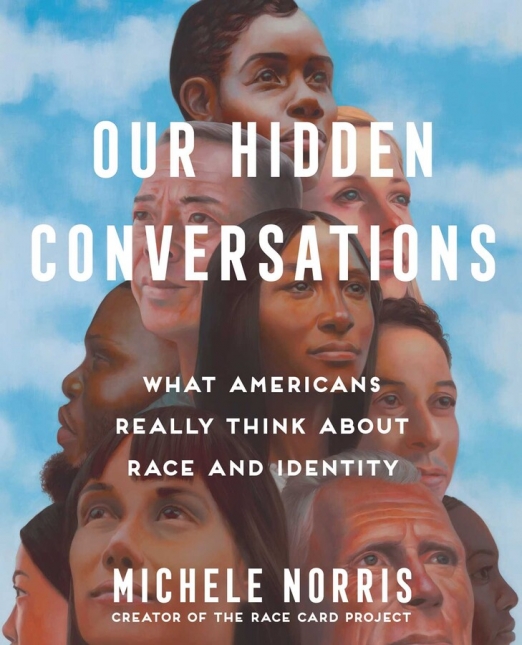Our Hidden Conversations: What Americans Really Think About Race and Identity
- By Michele Norris
- Simon & Schuster
- 528 pp.
- Reviewed by William Rice
- January 31, 2024
An intelligent, moving look at what color means to us.

There’s much commonality in Americans’ experiences and feelings about race, yet every story is unique. That’s just one intriguing and important lesson offered by Michele Norris’ sprawling scrapbook-cum-sociological-study, Our Hidden Conversations: What Americans Really Think About Race and Identity. The book is based on an ongoing project that invites ordinary people to share their insights on the racial divides that persist in our society. It’s another reminder that a broad, deep national injury like racism takes a long time to heal — and that healing only comes in halting, unpredictable stages.
In 2010, Norris — best known as the award-winning former co-host of NPR’s “All Things Considered” — began a crowd-sourced investigation into where we find ourselves in the 21st century on the slippery, confounding issue of race. Cleverly subverting a phrase wielded by impatient critics of such focus, she launched the Race Card Project: pre-stamped postcards addressed to Norris that she scattered in public places like restaurants and laundromats. The cards’ message for whoever finds one: “Race. Your Story. 6 Words. Please Send.”
Fourteen years later, Norris has received a staggering half-million responses (both as physical cards and electronically), each offering a kind of racial haiku:
“Black Boy. White World. Perpetually Exhausted.”
“You don’t look like a Mexican.”
“Lady, I don’t want your purse.”
“My grandparents met in the KKK.”
“Just what do you people eat?”
“I don’t get to be colorblind.”
“Hated for being a White cop.”
“Men I love aren’t safe here.”
“My daughter isn’t a ‘China Doll.’”
“Grandma feared Blacks. Grandson IS Black.”
About half the book consists of boxed text, several different-sized boxes to a page. Each contains one of the six-word phrases, the author’s name (a few entries are anonymous), and usually at least a brief backstory. Sometimes, there’s an accompanying photograph. The other half of the book is traditional prose diving deeper into selected stories.
Despite all the slights, outrages, doubts, fear, uncertainties, and anguish revealed by the entries, they also somehow constitute grounds for optimism. Everyone is obviously approaching race from a different angle, but there is a reassuring sameness to the emotions, ideas, and thoughts expressed. A picture emerges of a nation of fallible, vulnerable humans trying to feel their way from varying starting points toward an unseen but universally desired solution.
But make no mistake: Those starting points are very different. With only a few exceptions, every self-described person of color has suffered some kind of racism — almost always committed by white people — ranging from the irritating to the appalling. Meanwhile (beyond a small subset crying “Don’t blame me!”), white people are suffering the lesser pain of guilt over racial transgressions, either their own or, more often, their ancestors’.
The author reinforces a hopeful reading with her graceful, sympathetic, insightful oversight of the material. Norris, who is Black, is able to offer expert interpretation and explanation of white racism in all its myriad forms to the close-minded or ill-informed. But she displays equal-opportunity empathy for the human experience — whether suffering, frustration, or joy — regardless of the race of the person experiencing it.
There are eye-opening moments in the text for white readers like this one who pride themselves (probably foolishly) on their relative sophistication regarding matters of race. Comfortable assumptions about modern racial sensitivity are easily dispelled by the multiple postcards from this project headlined with the same six-word phrase, “You’re pretty for a Black girl,” a stinging “compliment” that apparently still makes the rounds with great frequency.
Norris relates the story of a young Black man explaining for the first time to his Black mother how he has successfully navigated the white world, describing the exchange as an inverted form of “The Talk,” the advice Black parents are forced to give their children — especially boys — about how to comport themselves safely in the larger society. Norris asks about this role reversal:
“What’s a parent to feel at that moment? Pride? Anger? Frustration? Vertigo?”
In keeping with the truth-telling mission of her project, Norris is unafraid to share her own feelings. A chapter on transracial adoption begins with the author’s visceral reaction to the chilling six-word entry “Black babies cost less to adopt.” While exploring the growing phenomenon of adoption across races, Norris declares herself in favor of it but adds a vital caveat:
“[A] child of color shouldn’t be a family’s only non-White acquaintance, nor…their first.”
She describes her parents’ overt patriotism as originally confusing but now “handy…as I try to explain to my own kids why it’s worth fighting for and defending, and yes, even embracing a country that will almost certainly break your heart.”
Norris’ revelation that the majority of entries have come from white people may seem at first like evidence of yet another instance of cultural appropriation. But looked at a different way, this project is precisely for white people. People of color cannot escape the subject of race, after all. It’s white people who must be enticed into thinking about it.
Our Hidden Conversations ends with an invitation to readers to compose their own six-word manifestos on race. Mine? “It’s more complicated than you think.”
William Rice is a writer for political and policy-advocacy organizations.
